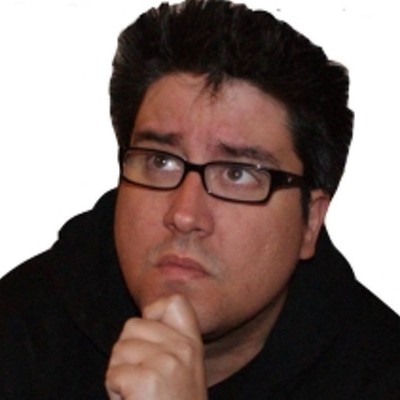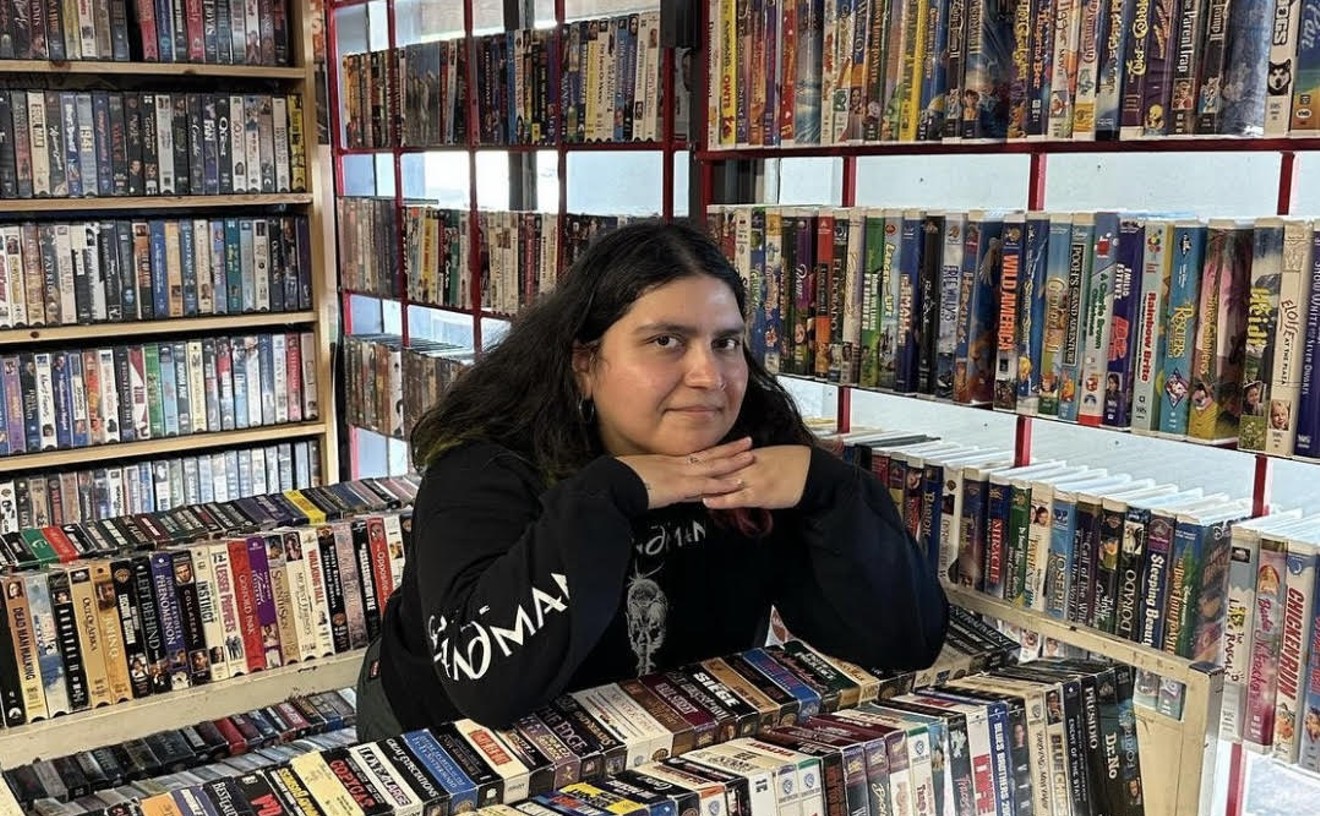"It's kind of an impossible film that shouldn't exist, but it's this crazy thing that seems to work," Krause says. "The film gods came together and allowed us to make it without any problems."
The script tells a complex story about an ordinary, timid man who loses his dog to a loan shark thanks to his loser roommate, and the levels he sinks to in order to save his one source of unconditional love. The film got an official release earlier this month with a screening at the Angelika Film Center and is also available to stream on Amazon Prime and Vimeo On-Demand.
It's a story that involves guns, cars, robberies and murder. Krause only had $1,500 to shoot his movie and the hours his cast and crew of five people could spare when they weren't at work. He also had no filming permits or permission from any official entities to shoot his movie in public.
It sounds like a cinematic recipe for disaster, but the result is surprisingly polished. The scenes seem like they were shot with a much larger crew, and from the exterior shots you have no clue that the camera operator is hiding in the corner, trying to get the perfect shot away from curious bystanders, or that a camera is just being stuck out of a moving vehicle on a major Dallas roadway.
"It took a lot of creative planning and mapping, but when you watch the film, you don't get the sense it was made for $1,500 and only had a cast and crew of five," says Simon Cardoza, who plays the main character in the movie and wrote the script with Krause and Matt Barron, who plays Simon's lazy roommate Matt. Cardoza and Krause have been making movies together since they were 16. "That's the sense of pride I get."
Krause, Cardoza and Barron started writing the script in September 2013. They began shooting toward the end of October, tackling one of the most complicated scenes first.
"The biggest scenes we needed to get out of the way and plan for were the robbery scenes," Cardoza says. "We had to get a little creative with that and decided to film on Halloween night so we would get away with wearing masks and running and acting as if we were heisting a place."
Krause says he wanted to get a shot of his characters holding up a McDonald's, which they'd surely have been arrested or shot for if they had just gone into the place with raised guns and voices. So he and his girlfriend, Nalani, wore Pokemon costumes and gave the employees some candy to make sure they didn't feel threatened while Simon and Matt just talked to them in their robbery masks as if they were Halloween costumes.
They shot other robbery scenes after hours at local bars with the owners' permission so they could get some footage of the robbers brandishing their weapons without raising the suspicion of an armed policeman or a civilian with a carry license.
"At some point, Simon would ask them what they think of this mask and he would pull the mask on and I would shoot some footage real quick and then he'd say, 'Hey, I've got to run real quick,' and we would shoot that really fast," Krause says. "We would shoot that 20 times and I had to shoot this as fast as I could to make it look like this epic robbery scene. Later, we shot scenes with the guns because the last thing we wanted was to get shot or arrested while we're doing this. We didn't even have the guns in our car or near us when we were shooting those [McDonald's] scenes."
Driving scenes can also be difficult to shoot, even if they aren't the kind of loud car chases that end with a Blues Brothers style pile-up. Louis, the third member of Simon and Matt's clueless Yakuza played by Liu Yi, drives really slowly on the Margaret Hunt Hill bridge during their crime spree, creating a great joke in a tense moment and inspiring genuine animosity in the other drivers who weren't in on it.
"It's a pretty dangerous shot because we were in two separate cars and the only way to get that shot was to drive super slow," Cardoza says. "We were going like 30 mph on the bridge at 10 a.m. and people were honking at us. People were pissed and we had to do a couple of turnarounds to get the shot that we needed. It's a little risky and kind of stupid, but at the same time, we needed that shot."
"Insurance would have been upset that we did that but we didn't do anything illegal," Krause says. "Basically we were just on the highway and I had the camera strapped to my neck and I just leaned out the window. If you look at the scene, [Liu's] actually going the speed limit and everyone else is speeding."
Shooting dialogue scenes on sidewalks and street corners may sound like a simpler, less reckless task, but those scenes presented their own challenges. People notice a large film camera on a tripod and tend to gravitate toward it, especially people piling out of bars on a Friday or Saturday night with heads full of overpriced liquor. Some of them still think photobombing or honking a car horn at a film crew are endearing forms of behavior.
"We had [lavalier] mics underneath the actors' shirts, so if you're just walking by, it looked like a group of guys just talking while we were really recording their audio," Krause says, referring to scenes he shot on a busy night on Greenville Avenue. "I had a longer lens about 20 feet away and I'm hiding behind my girlfriend. So it looked like I was just taking still shots of them."
Shooting in restaurants wasn't as difficult when grand larceny wasn't a part of the scene. By merely smiling and asking nicely they were granted quiet places to film scenes, like the meeting between Matt and Simon in a late night IHOP, away from other customers.
"Anytime we shot in a location that wasn't locked down by us, we would go and feel things out first," Krause says. "We'd talk to people and try to feel the environment and I would slowly pull out the camera. Simon and Matt were always miked, so I just turn those on. My girlfriend carried the audio mixer bag that looks like a purse. If we carried it, it would look a little more suspicious, but if she carried it, no one would think twice about her.
"It's mainly just about being very personable and asking, 'Hey, do you mind?' and sometimes they would say no and others times, they'd say yes," Cardoza says. "Having a small crew played to our advantage because wherever we shot, we didn't have to worry about that stuff and we never attracted attention."
Despite these challenges and workarounds, Krause says he found most people accommodating, friendly and willing to help.
Hello Gangster from Reserve17 on Vimeo.
"Dallas is actually known to be a really easy city to shoot in," he says. "People don't seem to shut you down if you pull out a camera, and if you ever need help, there are people who are willing to sacrifice some of their time because there's not as much going on here. Overall, people are just willing to help you out when you need it. When you pull out a camera, people are intrigued by what you're doing rather than trying to get you to stop."
Krause says that he could have raised more money to do a traditional movie shoot, which would have made things like securing locations and getting shots of moving vehicles much easier. But he viewed the challenge of Hello Gangster as a rite of passage in his cinematography journey.
"Robert Rodriguez and Shane Carruth both did super small debut features and both of them were huge inspirations for me to make this film. The more I thought about the way they did it, I felt like I was cheating myself by trying to do it with more money. Let's do it as crazy as possible and do it for nothing. Even $1,500, that's more than I wanted to say I spent. I wanted to say we spent $500. That's when you learn the most because when you have nothing, you have to get really creative."











